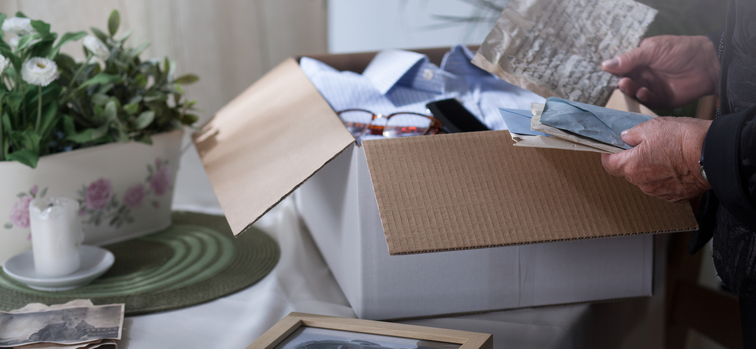
Our possessions are more than just inanimate objects. They tell stories about our lives and families. They’re sources of sentimental—or financial—value. So when packing for a senior living community, deciding what to take can be challenging. If you feel conflicted about the move, you might be tempted to take everything as a way to hold on to your old life. But this is just one more chapter in the grand adventure that is life. It’s a great chance to build a space that feels fully and uniquely you—without the demands of raising children, tending to pets, or catering to your family’s aesthetic preferences.
If that cluttered closet in the spare bedroom has taunted you for a decade, a big move gives you a chance to win the war on clutter. Moving to a senior living community usually means downsizing to a smaller living space. So you’ll need to prioritize the things that keep you comfortable and happy while leaving behind the things you no longer want or need.
What to Pack
Senior living communities are as diverse as the people who live in them. Some units come prefurnished, while others are yours to furnish and decorate as you see fit. Some communities provide all or most of the food you need, while others leave the cooking to you. The starting point for your packing, then, should be the recommended packing list of the community you’ve chosen.
Here are some starting considerations for your packing list:
Furnishings and Decor
Almost everyone feels comfortable in familiar surroundings. So even if your kids are fighting over your heirloom sofa or you are itching to redecorate, take a few familiar and much-loved items. A favorite quilt or blanket, a quality mattress, or an heirloom piece of furniture can all help your new living quarters feel more like home.
Some of the items you may need are:
- Linens, towels, curtains, a shower curtain, and a bath mat
- Area rugs; be sure to add anti-slip backings if they’ll be placed on hardwood or laminate flooring
- Seating, including chairs, a table, and a sofa or recliner
- A nightstand or bed table
- Extra clothing storage if the closet space is small
- Shelves for books or other personal items
When choosing which furniture to take, select items that offer a lot of storage relative to their size. A nightstand with long legs but only one drawer, for instance, offers little storage value. But a table with built-in drawers and an armoire with doors that expand outward both offer lots of space-saving storage.
Housewares
The housewares you need to pack will vary a lot depending on the community you choose. Ask specific questions about what is included and then pack items to ensure you have everything you need to remain comfortable and to complete daily routines. Some basic items to include are:
- Microwave
- Refrigerator
- Dishwasher
- Dishes, pots, and pans
- Coffee maker
- Utensils
- Food storage containers
- Trash cans for the kitchen, bathroom, and bedroom
- Pens and paper
- Hangers
Entertainment
How do you like to spend your time? And how do you plan to entertain others who visit? The answer varies greatly from person to person. For some, the key to entertainment may be packing lots of cookbooks and cooking supplies. For others, entertainment is a collection of indoor plants. Some items to consider are:
- Music and a music player, such as an MP3 player or small stereo system. Consider downgrading to a portable Bluetooth speaker that connects wirelessly to your phone.
- Computer or other electronic devices
- Television shows or movies on DVD
- A camera
- Your favorite books; if you have a large book collection, consider putting some of it in storage
Clothing and Personal Items
Deciding which personal items to bring can be the most emotional part of the packing process. It’s hard to put scrapbooks in storage, and you might be tempted to hang on to clothes you never wear, for sentimental reasons. Before packing anything, ask yourself if you use it. If the answer is no, it needs to go into storage or be donated.
Bring the following items:
- Clothing for all four seasons, including shoes, hats, scarves, casual and dress clothing, sleeping attire, socks, and underwear. Consider what you wear on a daily basis during each season and ensure you include those items.
- Family photographs to display in frames
- A safe in which to store valuables such as jewelry
- A file with basic information about your medical history, as well as a copy of your will, power of attorney, and other legal documents. Gather information on how to access your credit and financial accounts, too.
- Contact information for relatives, including an address book if you like to communicate via letter or card
- Items with sentimental, educational, or other personal value. Include these items if, and only if, you use them or enjoy them on a regular basis. For example, a special quilt can ease the transition, but a large collection of quilts may take up too much space. A small indoor plant collection can help your house feel like home, but a shed full of gardening supplies may get little use.
- Personal toiletries such as makeup, shaving supplies, cologne, lotion, brushes and combs, a hairdryer, a curling iron, and any other products you use regularly or periodically to get ready
Basic Household Supplies
Think about the items that you buy on a recurring basis to keep your house clean, ease minor discomforts, and cook excellent food. Consider packing:
- Cleaning supplies such as paper towels, cleaning spray, toilet-bowl cleaners, a plunger, a toilet wand, dish soap, and laundry detergent
- Toilet paper and napkins
- Cooking oils, seasonings, salt and pepper, condiments, and other items you regularly use to cook or flavor food
- Over-the-counter medications such as aspirin, as well as first-aid items, such as bandages and antiseptic spray
- Trash bags
What to Leave Behind
Clutter only makes life more stressful, so now’s a great time to get rid of things you don’t like or don’t use but have nevertheless kept. Try dividing items into three piles:
1. Keep in Storage
If you don’t have space for everything you want to keep, consider investing in a storage space. A small space may cost less than $50 per month. If a child or other family member has a basement or garage, that might also be a viable storage space. Consider keeping and storing:
- Collections, such as of books, that you’re not ready to part with
- Items you use seasonally, such as holiday decorations
- Items you like to switch out regularly. For example, if you have a large wardrobe you can’t part with, you might keep off-season clothing in storage.
- Items you want to bequeath to loved ones but that you do not want them to receive until after your death
2. Donate/Throw Away
If you don’t use it and your family is unlikely to want it, donate it or throw it away. Items in good condition can make someone else’s life brighter. They might also get you a tax deduction. So consider donating clothing, housewares, furniture, and similar items to a local charity. Damaged items, old papers, and soiled clothing and furniture should go in the trash pile.
3. Give to Family
Now’s a great time to pass on family heirlooms that you get little use from. Give your kids some items left over from their childhood or pass a baby blanket on to your grandchild. Jewelry you no longer want may thrill a niece or nephew, and a grandchild headed to college might love to have your spare couch. Consider giving away:
- Antiques
- Family heirlooms
- Expensive items you no longer use
- Sentimental items, such as books and baby blankets
- Furniture that’s in good condition
Managing the Move
Plan on packing slowly rather than doing it all the week—or the day!—before you move. This lowers the workload and gives you time to contemplate your packing decisions. Some other strategies that can help you pack for a move to a senior living community are:
- Organizing things as carefully as possible. Unboxing an avalanche of chaos when you get to your new home can be stressful and demoralizing.
- Asking friends and family to give you any boxes they aren’t using. Delivery boxes can quickly accumulate, and recycling them saves you money.
- Enlisting the assistance of friends, family, movers, or all of the above on the big day.
- Having a box or two of items you’ll need immediately. Put this box somewhere accessible so that you’re not digging for it on the big day.
By staying organized, you’ll make unpacking easier. And the sooner you can unpack, the sooner you can enjoy your new home.







